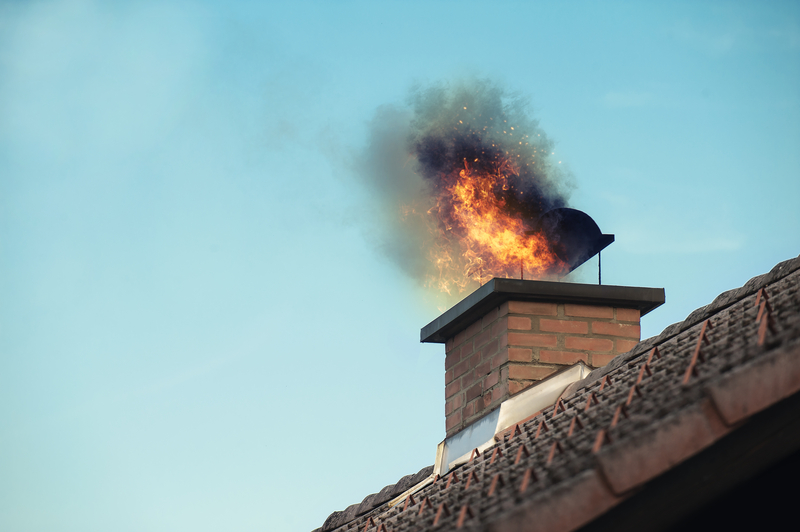
25 Apr Proper Maintenance and Usage is Key to Preventing Chimney Fires
A chimney fire is a dangerous type of fire that starts in your chimney and can quickly spread through your home. While these types of fires can be serious, most are preventable. By adhering to proper maintenance recommendations and proper usage, you can help prevent a fire in your chimney. The most important thing to consider is that failure to regularly inspect, repair, and clean a chimney can cause it to malfunction or collect dangerous build-up that puts your family at risk.
Proper chimney cleaning
Maintenance begins with cleaning; because clean chimneys don’t catch fire, only dirty ones do. When we say dirty, oftentimes it is a build-up of creosote, which is a highly flammable, dark brown substance that coats chimney walls. How does it get there? Chimneys expel by-products of combustion that include smoke, water vapor, gases, unburned wood particles, hydrocarbon, tar fog, and assorted minerals. As these substances leave the fireplace, they flow up into the relatively cooler chimney where condensation occurs. The resulting residue that sticks to the inner walls of the chimney is called creosote, which is the most common culprit of chimney fires.
If the temperature in the chimney flue (the space inside the chimney) is high enough, and the creosote build-up thick enough, creosote can catch fire—and that fire can spread and move up the flue.
To ensure a clean chimney, it’s a good idea to hire a professional chimney sweeper to inspect your solid fuel venting system annually and sweep and repair it whenever needed. Not only will they clean the chimney, but they will also inspect the area for any damage, obstructions, and creosote build-up. And if you notice a build-up of creosote in your chimney (you can gauge this by scratching your finger along the wall), it’s time for a cleaning.
Aside from cleaning, there are a few tips that can help reduce creosote build-up:
- Do not restrict the air supply.
- Keep the glass doors open.
- Be sure to open the damper wide enough. The longer the smoke is in the flue, the more likely is it that creosote will form.
- Do not burn unseasoned wood.
Another consideration to help prevent a chimney fire is to install a chimney cap. Leaves and animal nests inside a flue can quickly fuel a chimney fire when touched by loose embers from a fire. A chimney cap on the crown around the outside opening of the flue will keep debris and critters out, and it will prevent “back puffing,” which occurs when escaped smoke from a fire re-enters the chimney and then the home. It may also be a good idea to insulate your chimney flue. An insulated liner will help flue temperatures from getting too cool, which encourages fire by-products to condense and form creosote.
Proper chimney usage
Cleaning and maintenance are one thing, and proper chimney usage is another. Follow these tips to ensure a safe fire in your fireplace.
- Before starting a fire of any kind, always double-check that your fire extinguisher, smoke detector, and carbon monoxide detector are each in working order (with batteries).
- Remove anything flammable within three feet of the fireplace in case stray sparks escape the hearth.
- Keep a glass or metal screen in front of the fireplace to prevent embers or sparks from jumping out.
- Use safe fire starters; well-seasoned hardwood or CSIA-approved logs are the only fuels you should use in your fireplace or wood stove.
- Do not burn magazines, cloth, or cardboard in your fireplace.
- Open the damper to allow the smoke and ash to travel safely up the chimney. If you start a fire with a closed damper, the smoke will have no escape route and circle back into the house.
- Put the fire out before you go to sleep or leave your home. To safely extinguish the fire, spread out the wood and embers with a fireplace poker, then cover them with the ash lying at the bottom of the fireplace using a fireplace shovel. Then douse the cooled wood and embers with enough baking soda to cover them completely—the sodium bicarbonate will extinguish any remaining embers.
- Put cooled ashes in a metal container with a lid, outside, at least three feet from your home.
Follow these tips for the safe maintenance and use of your fireplace to prevent a tragic chimney fire in your home.
Read up on more home safety tips here: Practicing Fire Safety When Grilling Out – Michigan Fire Claims Inc.



